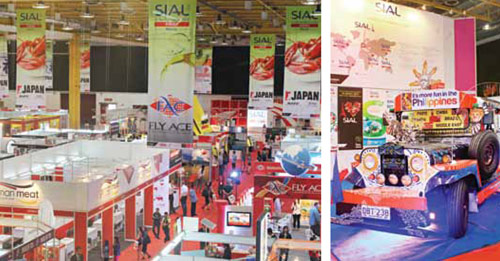
The organiser of the food event has to cross several hurdles, such as simultaneously running another show, to enable it to be held for the first time in the Philippines. By Marianne Carandang
Convincing representatives from SIAL, the world’s largest food tradeshow, of the Philippines’ potential to hold the event wasn’t easy, according to Jon Richmond Ang, marketing director for Worldbex Services, whose subsidiary Mafbex Events Management (MEM) executed the show.
The European food trade didn’t really know the Philippines, Ang explained. “But the Philippines has several advantages. We eat the most.”
He was referring to the Philippines’ largest consumption of food per capita in ASEAN, due to its population of 100 million.
He added: “We’re meat eaters; we eat pork, and we drink alcohol.”
This edged out neighbouring countries such as Malaysia and Indonesia, which have restrictions on both items.
But existing Philippine meat import restrictions were a concern. “We had to ensure that a lot of strict local rules and regulations were met – and that we could guarantee the safety of the delegates.”
In fact, SIAL representatives had visited Manila in 2013 and saw how Worldbex stage Manila Food and Beverage Expo (MAFBEX), Worldbex’s own consumer tradeshow, that has been running since 2006. The visit helped clinch the deal.
The show’s trademarks include culinary workshops from top Philippine chefs and competitions attracting students from the booming culinary school industry.
“We could always opt to have a different date and a different venue (for SIAL ASEAN), but since this was SIAL’s first time in Manila, we thought, why not have it together with MAFBEX and show the international buyers how Filipinos put up a good show,” Ang shared.
“We had to make sure that the message was very clear, that one show was B2B and the other B2C, and that putting them together made for the biggest food tradeshow (to date),” he said.
Marketing and promotion for SIAL were done in-house. The show would sell the Philippines as the “Best Kept Secret for Food and Wine Business in Asia” to address the market’s lack of familiarity with the destination.
Sound logistics also played a part in the events’ success. “It was the first time we organise two shows in one venue, so we had to really study the logistics of it all – traffic management, security measures, among others,” said Ang.
An additional tent connecting to an existing one and the nearby Philippine Trade Training Center, a government facility, had to be constructed to acommodate all participants from both shows.
SIAL ASEAN enabled many first-time visitors to experience good Philippine service, from airport reception to the 24-hour shuttle services to and from partner hotels.
MEM also organised a gala for 400 delegates at the Blue Leaf Filipinas pavilion in nearby ASEANA City, who were welcomed by folk dancers and indigenous tribesmen in colourful traditional outfit.
There were also two special pavilions, one showcasing demonstrations from top chefs, while another highlighted groundbreaking product, packaging and processing innovations.
Additionally, MEM hired external help to organise a total of 700 pre-arranged meetings, which were held at a special lounge at the expo.
Although a little short of its target, SIAL ASEAN drew about 7,500 participants, 197 exhibitors, the bulk of which came from Japan, South Korea, China and Europe, and over 60 hosted buyers.
Apart from a proud moment when SIAL ASEAN bestowed a “best in innovation” award to Fisher Farms Inc, a Filipino aquaculture grower and food processor, Ang shared another achievement: “SIAL ASEAN will be held here again in 2016. The Philippines, it is.”






















